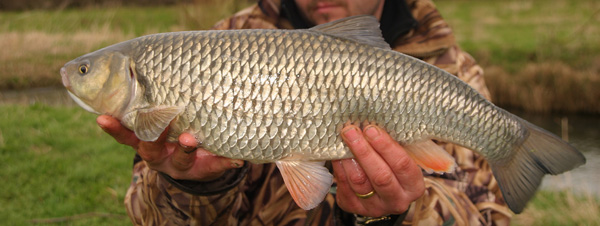Back in the late sixties to early seventies a Kent angler by the name of Fred Wilton, assisted by a few of his friends, had a theory that he could vastly improve carp paste baits. Fred started to make baits containing high levels of proteins; these were made from various milk-derived ingredients including casein and calcium caseinate to which he added various vitamins and minerals.
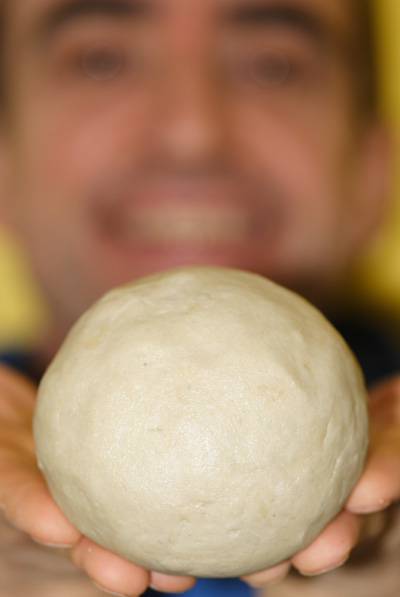 His theory was if you gave fish food that was better for them they would instinctively know it was far more nutritionally beneficial for them to eat that food item to the exclusion of all other baits. These baits were to become known as HNV baits (high nutritional value) and later as high protein baits.
His theory was if you gave fish food that was better for them they would instinctively know it was far more nutritionally beneficial for them to eat that food item to the exclusion of all other baits. These baits were to become known as HNV baits (high nutritional value) and later as high protein baits.
The boilie was a direct descendant from these HNV pastes and anglers were very successful catching carp on them but they also caught a lot of ‘nuisance’ fish because the bait was soft, so the paste was made with eggs and boiled, hence the first boilies were created.
Fred Wilton and his boys were way ahead of everyone else when it came to boiled baits and HNV’s for barbel, simply applying what they had learnt from their carp fishing, to running water. Little did Fred know that when he first made those baits the far reaching consequences to the river angler were to be beyond anything he ever could have imagined. Whole stretches of river were emptied by anglers who caught fish almost at will. It got to the point that if they didn’t want to catch a fish then they didn’t cast a bait in. It didn’t matter what the conditions were like; come rain or shine they out caught everybody around them.
Of course, no secret can ever stay a secret for long. In time other anglers began to hear of these baits and their almost magical properties and wanted to try them for themselves.
It wasn’t until the 1980’s when a massive step forward in carp fishing came along in the form of the hair rig, which was first thought of by Lenny Middleton and Kevin Maddocks. This hair rig saw anglers catch rate improve beyond all recognition and open a new era in carp fishing.
My relationship with milk protein baits stretches back to around early 2000. At the time I was totally blown away by the articles of Tony Miles in the now defunct ‘Coarse Fisherman’ magazine. Every month I was mystified and totally in awe by his captures of mammoth barbel from places such as Kickles Farm and Adams Mill. He nearly always mentioned his ‘special’ baits within his articles but at the time I could not fathom exactly what sort of bait it was. All I knew was that it was highly specialised and caught him a hell of a lot of fish.
Fast forward eleven years to 2012 and the purchase of Tony’s excellent book – ‘Elite Barbel’. By this time I had developed into a true specimen hunter with big chub being my number one target. By reading through ‘Elite Barbel’ and with my chub head firmly screwed on, it quickly became apparent by the number of accidental chub captures that it was a bait that the chub loved. It wasn’t just the number of chub that he caught but the size of them. It certainly appeared to pick out the bigger fish.
So why, I hear you ask, did I decide on a milk protein base mix for my chub fishing for the foreseeable future and how can I justify the expense and the attached stigma that seems to go from using such a bait? Well in fact there are a number of highly valid reasons that are very relevant to my fishing.
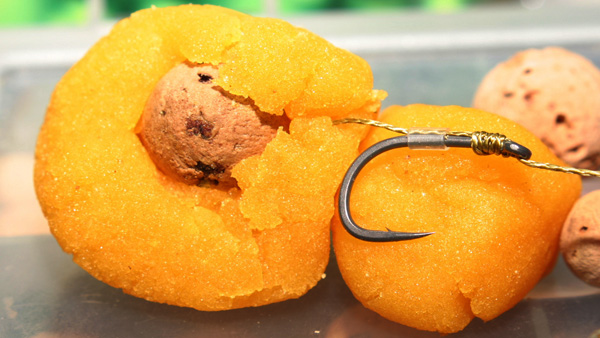
95% of my chubbing these days revolves around fishing stretches of river of which are deep, slow moving, and with a low density of nomadic, but big, chub. They are also very lightly fished for and it’s rare to see another angler in months of fishing day sessions. Chub populations on these stretches are always almost low and only a handful of fish may present in a mile or so of river, provided of course that you can find them in the first place.
In my opinion these slow water chub have opted for a state of ‘semi-retirement’, free to live out quiet, untroubled lives, away from the competition that shoal chub have to live with. Chub in these stretches are usually on their own, in pairs, or occasionally in small groups, in much the same way that the largest barbel live solitary lives, spending their time travelling miles throughout the river systems which they inhabit.
Therefore location on such a venue becomes absolutely critical. It was not a case of picking a likely looking swim and proceeding to fish it. Fishing in this way I was lucky if, on average, I would get two bites in ten full day sessions.
I learnt that good bait placement in a swim was also vital. This was the first year that I have spent plumbing up miles of river, and in the process, I learned an awful lot about my usual swims, noting such features as weed beds, snags, silt, gravel patches, etc. In two hours of plumbing up and feature finding I learnt more in that time about my river than I did in a whole season of fishing blind. Most importantly of all I was interested in depressions or holes, in otherwise uniform and seemingly featureless sections of river. Depressions such as these, especially if they are gravel, are natural holding areas for fish because of their ability to act as natural food larders. Another advantage of all this intense plumbing and mapping was I began to fish swims that I normally would have walked by or would not have given a second glance, purely on the basis of how they looked from the surface. You can never really get to know your river unless you do some mapping of the underwater features and these days I always carry a marker rod with me for this purpose.
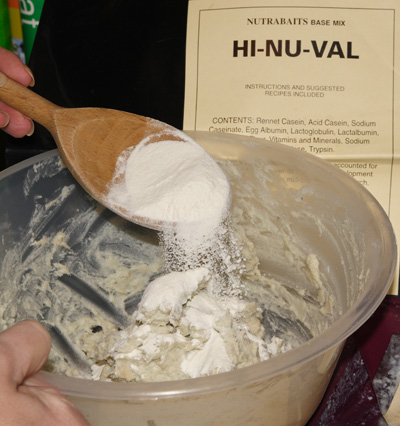 Furthermore, on my river, it was virtually impossible to spot fish unless they were under your feet because of the river’s murky water clarity. Even in the height of full summer and in the shallowest parts fish spotting was virtually impossible on all but the brightest of days. At least with the extensive plumbing I had carried out I knew where to place my bait so that I would not be fishing blind as I had done in previous years.
Furthermore, on my river, it was virtually impossible to spot fish unless they were under your feet because of the river’s murky water clarity. Even in the height of full summer and in the shallowest parts fish spotting was virtually impossible on all but the brightest of days. At least with the extensive plumbing I had carried out I knew where to place my bait so that I would not be fishing blind as I had done in previous years.
Milk protein is a very addictive food stuff for all fish and it quickly became apparent after talking to Tony, that big chub absolutely love it. The other point is that, once fish have tasted it, they will actively search it out in preference to other baits. This is why it can be so devastating on lightly stocked venues. On the venue where Tony conducts his fishing, he has taken some huge chub in recent years. It is also lightly stocked and all of those fish have come on milk protein based baits.
However, if you have a greater concentration of fish with no location problems then the expense of milk for chub is unnecessary. If I know where the fish are, I am just as happy chubbing with bread, fishmeals, meat or cheesepaste. It’s only where there are a few nomadic big fish that the addictive qualities of milks help in the location process. This can save a lot of wasted time. Chub (and other fish) will move upstream 50 yards or more once they’ve detected the distinctive label of a milk bait. You haven’t got this pulling power with other baits and swim selection is therefore far more critical. With only a few big fish in the stretch, then it becomes more of a game of chance.
Think of it like trying to hit a bullseye in a game of darts with your eyes closed – it’s anyone’s guess where you next shot will land. Now think of throwing with your eyes open; you have a much higher percentage likelihood of hitting the bull. In other words being able to see pushes the odds in your favour. This is what a milk protein bait does – it tips the odds in your favour.
Milk proteins can be great baits but to get the best from them they are best used as part of pre baiting campaign. I believe this to be single most important thing with this type of bait. The idea being to wean the fish onto them and so that when you go fishing, you only need to use a few baits at a time.
As a rough guide the higher the protein content of the base mix the smaller amount you need to put in especially in the winter when it very easy to fill the fish up. Always err on the side of caution and remember – what you put in you can’t take out. If you do ‘pile it in’ all you will succeed in doing is filling the fish up for days or even weeks. Not only will this ruin your fishing but it will also destroy the chances of others. It’s important to use milk proteins responsibly and sparingly and not to go overboard with their use.
I use them on the premise of 0.5kg of milk protein such as Hi-Nu-Val or Supermilk is equal to 2kg of fish meal boilies. If we think of milk proteins in these terms it equates to 5kg of milk protein being equal to 20kg of fishmeal boilies. If the bait costs twice as much and is equally as effective but you only need to use half the amount then the difference in price is negligible.
Over the last couple of years I have finally got my head around the use of flavours in my bait. Simply put it’s a fact that commercially a bait MUST have a smell or people won’t use or continue to buy it. Flavours are similar to lures/floats in that they catch the angler rather than the fish. The choice of flavour is largely irrelevant with milk proteins. The point I’m trying to make is that a flavour merely gives you bait a ‘label’ which distinguishes your bait from others. In reality a good, quality base mix, doesn’t even need a flavour of any kind for it to work – the proof of the pudding, as they say, is in the eating!
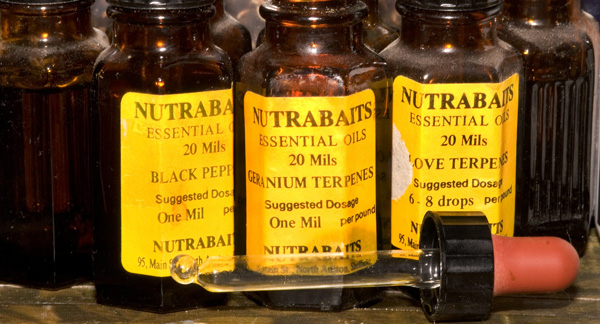
From my own personal opinion the worst thing you can do with a milk protein bait is overload it with flavours. If you are going to do this then you might as well just chuck your money in the river. A highly over flavoured bait will blow very quickly indeed no matter what base mix you use, so you would be far better off using an ‘attractor’ base mix such as a 50/50 mix.
These days I consider baits such as cheesepaste, flavoured luncheon meat, or any highly flavoured bait for that matter, purely as an out and out ‘attractor’ bait, or as I now call them – a ‘novelty’ bait, taken for its attraction values rather than its nutritional value. Ok for that ‘instant hit’ but not for long term usage!
I generally use these novelty baits in conjunction with quiver tipping when I’m pioneering new stretches of river in order to ascertain numbers of fish present.
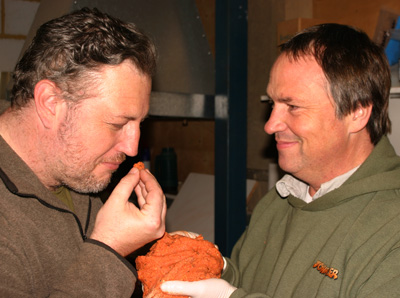 These days I use less than half of the manufacturer’s lowest recommended dosage level, and my results have not suffered as a result of doing so. The flavour levels are so low that they can barely be detected by the human nose, but the fish can certainly still find it.
These days I use less than half of the manufacturer’s lowest recommended dosage level, and my results have not suffered as a result of doing so. The flavour levels are so low that they can barely be detected by the human nose, but the fish can certainly still find it.
It’s also worth noting at this point that although we are talking about milk protein based baits in this article; there is no reason why you cannot use fishy, spicy or meaty flavours as opposed to more fruity and creamy flavours that are normally associated with these types of base mixes. Back to Tony Miles again who used a milk protein bait with a fishy flavour to achieve some stunning captures of big chub!
Whichever flavour you choose try not to make it an obvious flavour or one that is in general use and keep it strictly to yourself. Do not divulge it to anyone.
By this I mean that everybody knows what scopex, blue cheese, monster crab or garlic smell like. There is no doubting that these are very effective flavours but consider the fact that it only takes one person to suss your flavour, introduce it on an inferior base mix, and voilà! Your bait quickly loses its edge and blows. You could even go to the extreme of contacting a flavourist like RD Campbell and get them to create you a unique custom flavour only available to you.
It could well be a better bet to use a combination of flavours or low levels of essential oils as these will be far harder for somebody to mimic. Essential oils especially are very hard to mimic because of their natural make up, and because they are used at such a low level in the bait, will be very hard to copy. The only problem with using essential oils is that it’s very easy to overdo them. Use them in moderation.
Remember with a milk protein bait you are not trying to alter the smell of the bait. I’m convinced that the real pull of milk baits is the protein signal from the base mix, pure and simple. Whatever flavour you choose to use gives the fish a recognition signal. You are NOT trying to change the essential flavour of the milk protein.
I can see the other side to the argument though. In a situation where you are moving from venue to venue, and where a baiting campaign has not been carried out, you may well need that extra attraction from a higher flavoured bait to get that bite. Low level flavour baits, best for long term use, take time to establish. The trick therefore is to increase the flavour levels but not to a point where it is too high. Even in an instant bait the flavour can be so high that it is bitter and not palatable to the fish.
I also, for one, do not subscribe to the theory of upping the levels of flavour in my hook baits to make them stand out. To me this seems somewhat counter-productive where an extensive pre-baiting campaign has been carried out with an expensive milk protein bait, in which freebies with minimal flavour levels have been introduced. Why go to the trouble, expense and time of employing an effective pre-baiting campaign only to curtail the effective life of your bait by using an over flavoured bait, which will, in all probability, make your bait blow a lot quicker than it normally would?
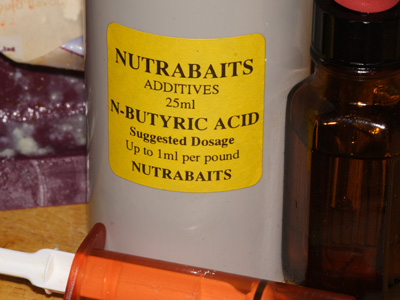 Far better to use a paste wrap on your boilie made from exactly the same base mix as your boilie is made from, sticking with the same level of flavours and attractors. A paste used in this manner still provides that initial kick of attraction as the attractors are not locked inside the boilie during the boiling process. I nearly always employ a paste wrap as I’m convinced that the bits of paste breaking away from the boilie in situ is a powerful extra attraction.
Far better to use a paste wrap on your boilie made from exactly the same base mix as your boilie is made from, sticking with the same level of flavours and attractors. A paste used in this manner still provides that initial kick of attraction as the attractors are not locked inside the boilie during the boiling process. I nearly always employ a paste wrap as I’m convinced that the bits of paste breaking away from the boilie in situ is a powerful extra attraction.
Some more good tips if you want a good attractor bait for the winter is to use very low flavour levels in your boilies but glugging them on the outside with a watered down version of your chosen flavour. It provides an unrivalled initial burst of flavour that fish home in on but by the time they have eaten the bait most of the glug has washed off leaving a bait that is not overpowering to eat. This way you get the best of both worlds. Another good tip is to put some dry base mix in with your boilies whilst they are defrosting. Those tiny bits then wash off and provide another form of attraction
It may be beneficial, when fishing with some milk protein based baits, to add n-butyric acid. With milk proteins an enzyme additive to help break down the high protein so it’s more digestible can be desirable. Using n-butyric acid will aid the breakdown, without it the boilie or paste mix will turn to a gel in their gut and make them feel full up.
Other natural enzymes such as trypsin (which is found in crayfish and Chinese mitten crabs in very high doses) and is present in the pancreas, are basically activated by other enzymes and processes in the intestine of the fish which actually enables the fish to eat more high protein foods. So if you hear people saying that fish in places with crayfish in are getting bigger, I believe it’s a mix of protein food (the crayfish meat) with high levels of trypsin working more effectively to gain mass and weight. The more they eat, the more they can eat, thus gaining weight.
The milk protein on its own won’t contain any trypsin, because it’s a naturally occurring enzyme present in the pancreas of mammals and fish/shellfish. It just helps breaks the proteins down into smaller blocks thus passing through the system more easily and quicker, allowing for more protein intake, therefore they can eat more, giving you better odds on getting a bite as they don’t fill up and then sit under a bush for hours digesting it.
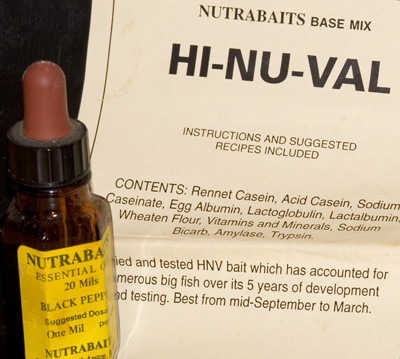 Interestingly Nutrabaits Hi-Nu-Val already contains trypsin in the form of Bengers. Bengers figured highly in many of the early enzyme baits; it is rich in the enzymes amylase and trypsin and when used with milk proteins gives a superb, easy to roll bait. Bengers was originally a food supplement formulated for children with ‘stomach troubles’ and also sold as an ‘invalid food’. It was a white powder (similar to Complan or Horlicks) that could be mixed with milk or drunk with tea, cocoa or coffee.
Interestingly Nutrabaits Hi-Nu-Val already contains trypsin in the form of Bengers. Bengers figured highly in many of the early enzyme baits; it is rich in the enzymes amylase and trypsin and when used with milk proteins gives a superb, easy to roll bait. Bengers was originally a food supplement formulated for children with ‘stomach troubles’ and also sold as an ‘invalid food’. It was a white powder (similar to Complan or Horlicks) that could be mixed with milk or drunk with tea, cocoa or coffee.
Through my exhaustive research I have found a source of pure powdered trypsin available to buy in the UK but at £17.98 for 25g it adds significantly to the overall cost of your bait. We then have to ask ourselves if it’s worth the extra cost by adding it to our milk protein bait when other substances such as n-butyric acid cost less and have the same effect.
To further aid digestion and improve gut transition times, there are other products on the market such as the Nutrabaits Addit Digest which can be added. Furthermore Nutrabaits Addit Digest contains bromelain and trypsin.
There are, of course, a few other tricks that can help make your bait more digestible in winter if you don’t like the idea of adding supplements such as the above to your baits.
You can use products such as bran, wheat germ, or bird seed. These sources of roughage decrease gut transit time but be especially careful with bran and wheat germ as both of these ingredients are quite light in their nature and adding too much will make you bait float. No one wants ten kg of pop-ups!
It’s also worth noting that some milk protein base mixes (although not strictly pure milk protein base mixes) such as Essential Baits Creamseed and DT Baits Cold Water Mix already contain a small percentage of birdfood ingredients. Birdfood also helps make a bait coarser which in turn helps the flavours and attractors leak out more effectively.
The main protagonists against such baits for chub are those who do not have the experience, insight, knowledge, or inclement, to make such dramatic changes away from the more traditional methods of chubbing. It’s very easy for people to dismiss a bait based on a purely theoretical assessment without experiencing it for themselves. Without actual extensive practical time on the bank how can they ever hope to back up their claims?
If you are not using some proportion of milk proteins for your chub fishing then you are missing out. I can assure you that Terry Lampard doesn’t mix his Trigga base mix with a milk protein for his winter chubbing just for the fun of it.
Guidelines for Milk Protein Baits
• If you are going down the milk base mix route, apply it properly; don’t pile kilo after kilo in.
• Work out a pre-baiting plan and stick with it.
• Keep flavour levels to very low amounts to ensure the bait has a long life span.
• They are expensive but the advantage is that you do not need to use the quantity that you would of other baits; quality over quantity.
• Milk proteins have a tendency to go off quickly, especially in hot weather. Take them out of the freezer just before you go fishing so that they are as fresh as possible and still frozen. Either keep them in a thermos flask or place a couple of freezer blocks in your bait bag to maintain their effectiveness.
• Keep the base mix in the freezer or fridge. Storing it like this helps it to stay fresher for longer and stops the nutrient content from denaturing. The dry mix doesn’t freeze as there’s no moisture content. Stored this way is should last well over a year or more.
